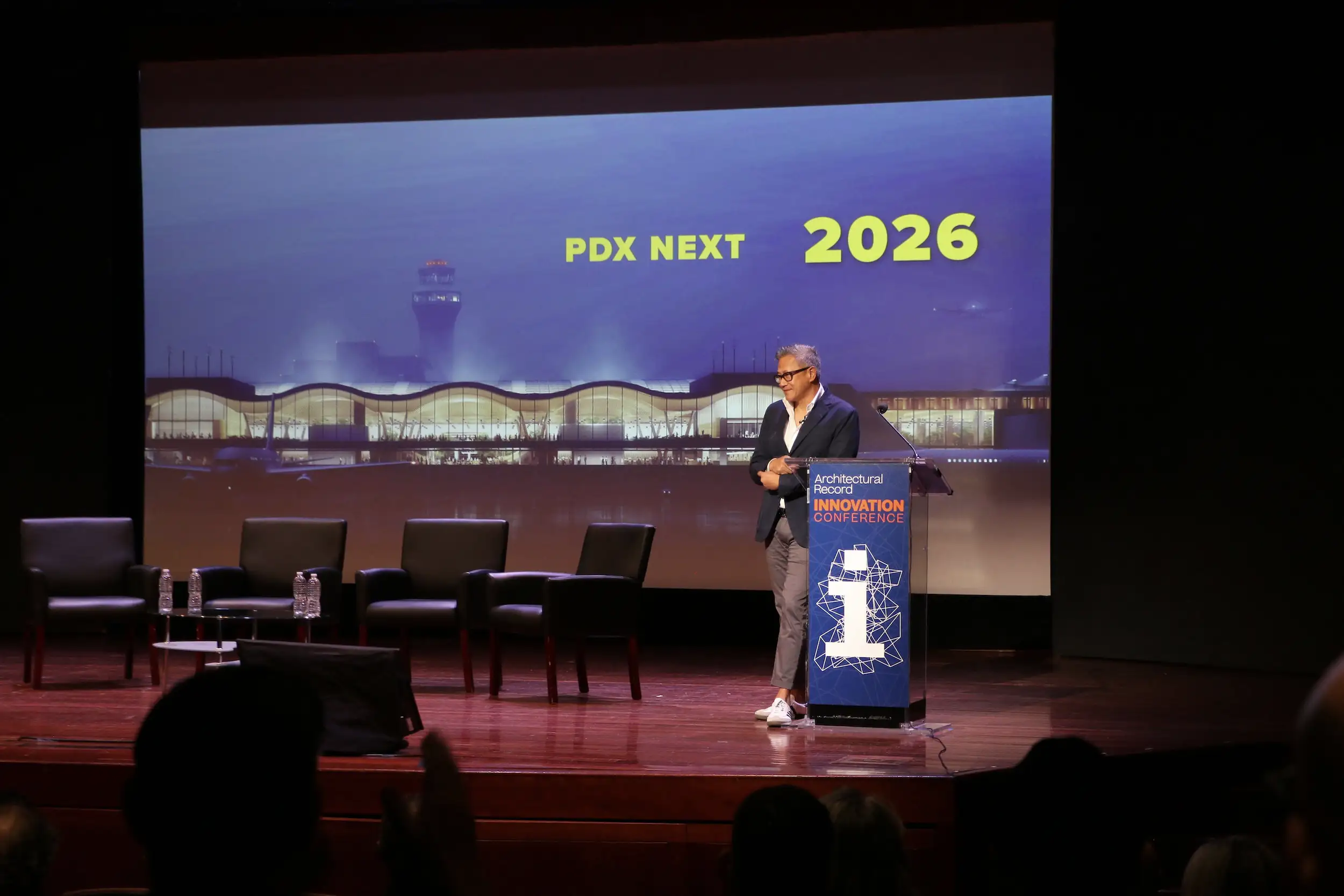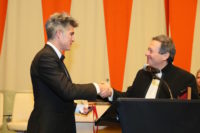Architects Gather to Discuss ‘Building Now’ at RECORD’s 2024 Innovation Conference

On October 1, RECORD hosted the 2024 edition of its Innovation Conference at the Museum of Jewish Heritage in New York City. Nearly 300 attendees representing a wide-swath of the AEC industry—firm leaders, architecture students, and design media professionals among them—gathered for the full-day event, which this year took on the broad thematic focus of “Building Now.” The program included presentations from and conversations with a lineup of leading international architects, joined by a celebrated artist whose work has transformed, both temporarily and permanently, the built environment in cities across the globe.
The 2024 conference had a mix of solo presenters—including four founding and co-founding principals of eponymous architecture studios—and two panel discussions: one on the challenges and opportunities of carrying out projects in the present day, and the other an in-depth conversation on mass timber construction. Two of the projects showcased, Casa 720 by Fernanda Canales and ZGF Architects’ main terminal expansion at Portland International Airport, appeared on the September and October covers of RECORD, respectively.

RECORD publisher Alex Bachrach greets conference attendees. Photo © Laura Stiles
Mexico City–based Canales kicked off the day with a brisk but insightful survey of 10 projects across a range of programs, scales, and contexts; all were completed within the last seven years, some within the last year. Projects discussed included off-grid second homes in rural Mexico (including the Record House–winning Casa 720 (2024) and Casa Terreno (2019); experimental, low in-come housing; and transformative civic projects—community hubs, libraries, public squares, and more—located in both one of the densest, most disadvantaged parts of Mexico City and in marginalized border towns in the Sonoran Desert. “I'm more interested in the space that belongs to one but affects all,” said Canales, adding of the profession: “Architecture has great power in the lives of people—so can we shape meanings and get involved in different ways? How do we position ourselves and how do we stand in this world?

Leo Villareal. Photo © Pansy Schulman, Architectural Record
New York–based artist Leo Villareal followed Canales on stage. In his globe-spanning presentation, Villareal highlighted the intimate relationship between architecture and his LED light installations—works, often large-scale, that meld intensive computer programming with his formal training in sculpture. Villareal discussed numerous projects, from subway stations to college campuses to the storied bridges of the River Thames. Several buildings featuring his work, such as Toranomon Hills Station and Lindemann Performing Arts Center at Brown University, have recently appeared in RECORD. “I love working in academic environments—places where people are studying art, architecture, engineering, and programming,” said Villareal. “My work is a hybrid that combines all these different ideas together; and I think that is what’s happening in academia these days—a blending of things and breaking down of barriers that gets all different groups of people together.”

Gene Sandoval.. Photo © Pansy Schulman, Architectural Record
Moving from hypnotic light installations to impressive feats of civic-scale mass-timber construction, Gene Sandoval, design partner at ZGF, next detailed how the soaring, Pacific Northwest–evoking Main Terminal expansion at PDX came together—all without disrupting normal airport operations while under construction. Aided by the extensive prefabrication of mass-timber components, fastidious planning, and some distinct geographic advantages, the herculean $2.15 billion project, partially debuting earlier this summer, was designed to accommodate an anticipated leap from the current 19 million to 35 million annual passengers. “I think this project is a reminder for all of us, as we talk about mass timber and sustainability, that there is a bigger mission: the power of architecture to move societies, to give optimism, to bridge differences,” concluded Sandoval. “In this case, it was a city and smaller towns working together to create a vision. And for Portland, where we are having a bit harder of a time getting out of the pandemic, this is such a blessing.”
Following Sandoval’s presentation, he was joined on stage by 2024 Women in Architecture Awards honoree Susan Jones, founder of Seattle-based atelierjones and a national leader in the mass timber community, and John O’ Donald, regional director at WoodWorks – Wood Product Council. In a discussion moderated by RECORD deputy editor Joann Gonchar, the three featured panelists discussed the evolution of North America’s burgeoning mass-timber construction scene, including notable milestones and road bumps along the way. “Mass timber isn’t going to save the world, but it is part of the solution,” remarked Sandoval.” “Building with mass timber isn’t really that hard. Yes, it takes a little more time to catch on—when people do catch on, they realize how fast and simple it really is.”
.webp)
Níall McLaughlin. Photo © Laura Stiles
The next speaker, Irish architect and educator Níall McLaughlin, began his presentation with a look at his London-based firm’s Presences installation at the 2018 Venice Architecture Biennale. Using that smaller-scale work as a springboard to discuss the design ethos of his practice, McLaughlin discussed several projects realized with historically significant environments, with the underlying theme of how architecture creates a series of connections and continuity through time. Buildings discussed were the Faith Museum at Auckland Castle; Bishop Edward King Chapel at Ripon Theological College, Oxford; the Sultan Nazrin Shah Centre at Worchester College, Oxford; the International Rugby Experience in Limerick, Ireland; and the 2022 Stirling Prize–winning New Library at Magdalene College, Cambridge. Also featured were Saltmarsh House, a 2023 Record House located on the Isle of Wight, and an unbuilt outpost of British cancer support charity, Maggie’s Centres. Describing his 30-person studio as being “constituted around the idea of a collegiate form of practice,” McLaughlin added: “I don’t design by myself in the dark room. I always design around a conversation, either with clients or with my team. And it’s that discussion—that idea of meeting something outside yourself as you’re designing—that’s at the heart of my architectural thinking.”

John Patkau. Photo © Laura Stiles
Next, McLaughlin was joined on stage by Canales and John Patkau, co-founder of Vancouver-based Patkau Architects for the day’s main panel discussion on “Building Now.” Moderated by RECORD editor in chief Josephine Minutillo, the lively and wide-ranging conversion touched down on topics such as the climate and housing crises, pedagogy, social media, ongoing challenges, and new opportunities.
Following the round table discussion, Patkau then gave the concluding presentation of the day with a talk entitled “Material Operations” centered around a core focus of his 40-year-old practice established with his wife Patricia. “As our office transitioned into a digital practice, the habit of making models diminished in our office,” explained Patkau at the beginning of his talk. “In reaction to that, we started to focus more consciously on the materials that we made the buildings from and the characteristics of those materials—we challenged what conventional building materials could be.” Projects that showcase the firm’s embrace of material innovation include a pair of British Columbian residences, one being Arbour House, a 2024 Record House; Yasodhara Ashram’s Temple of Light, also in B.C., a series of flexible plywood skating shelters erected in Winnipeg; and a stainless-steel variant of those structures commissioned by Comme des Garçons for a retail venture in Tokyo’s Ginza district.

2024 Women in Architecture Awards honorees (left to right): Toni L. Griffin, Mimi Hoang, Susan Jones, and Angela Brooks. Not pictured is Kate Simonen. Photo © Laura Stiles

RECORD deputy editor Joann Gonchar presents the 2024 Women in Architecture Awardees. Photo © Laura Stiles
Following the conclusion of the Innovation Conference, many of the attendees gathered with new guests at an evening reception and ceremony held at the museum to honor RECORD's 2024 Women in Architecture Awardees. Now in its 11th year, this year’s program recognized Innovation participant Jones along with Angela Brooks, principal & president of Los Angeles and Fort Lauderdale–based Brooks + Scarpa; Mimi Hoang, co-founding principal of Brooklyn-based ARCHITECTS; Toni L. Griffin, founder, urbanAC; and Kate Simonen, founding director of the Carbon Leadership Forum. Deputy editor Joann Gonchar presented the awards to the recipients, save for Simonen who accepted her honor via a video message.




Conference speakers, past Women in Architecture Awards honorees (and jurors), and guests socialize at a reception. Photos © Laura Stiles
Encouraging any young architects in attendance to follow their passions, Brooks said upon accepting the award: “What is your purpose and what energizes you? Figure that out and don’t get derailed by those who try to define our profession; some of the best, most innovative, and fulfilling work we have done grew from our passions and a stubborn insistence to not take no for an answer.”
Brooks added: “And also remember that your clients may not come from places that you expect, and that’s okay. What we do as architects, I believe, is really alchemy. It’s sort of magic, from the practical to the ephemeral, in small and big ways, and we can improve people’s lives. And knowing that is the key to being happy and successful.”



